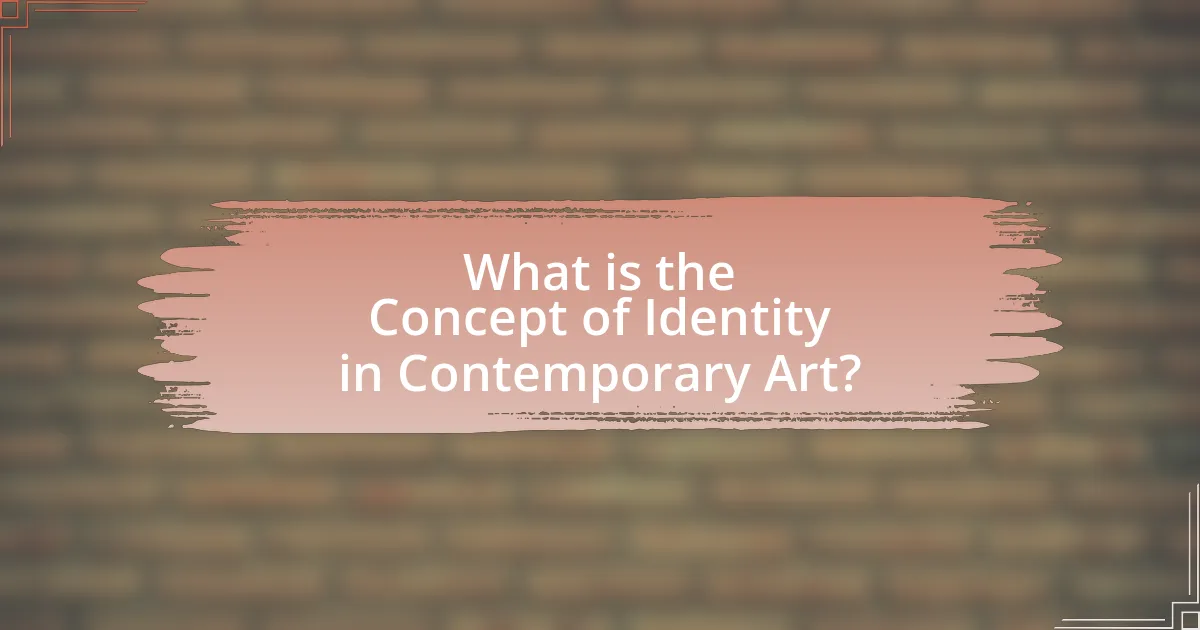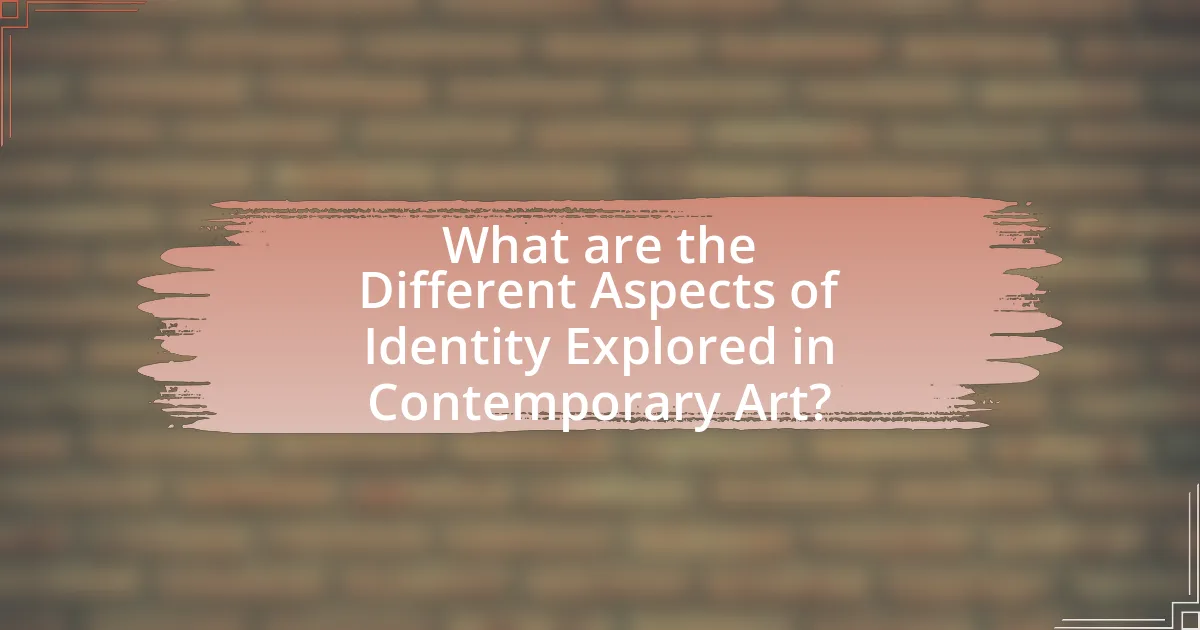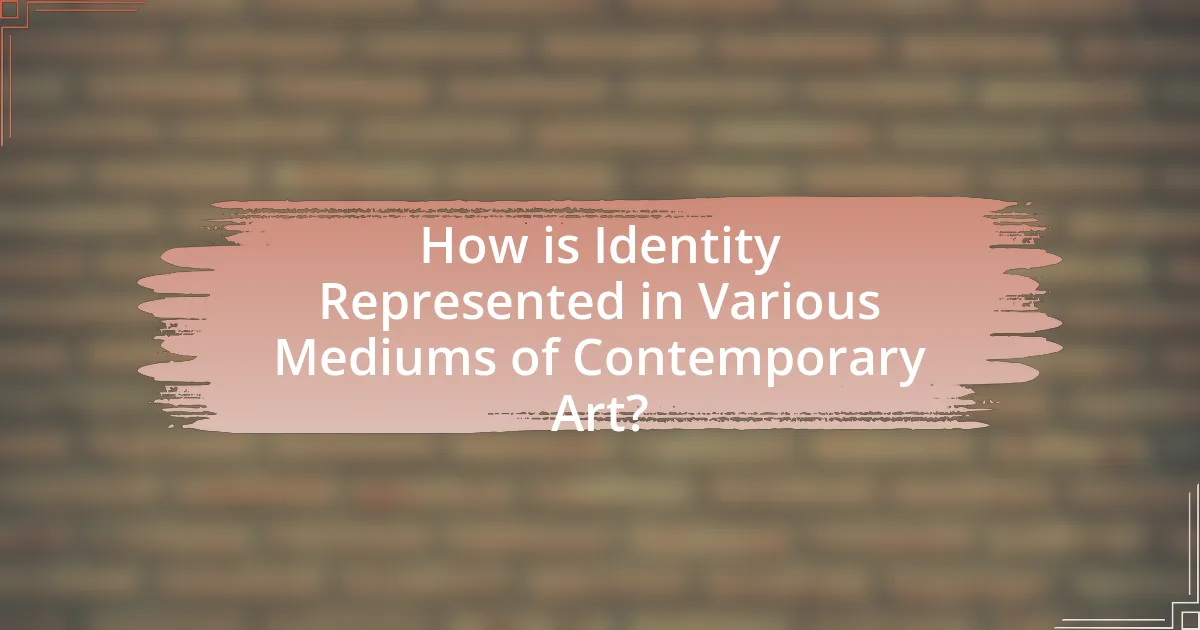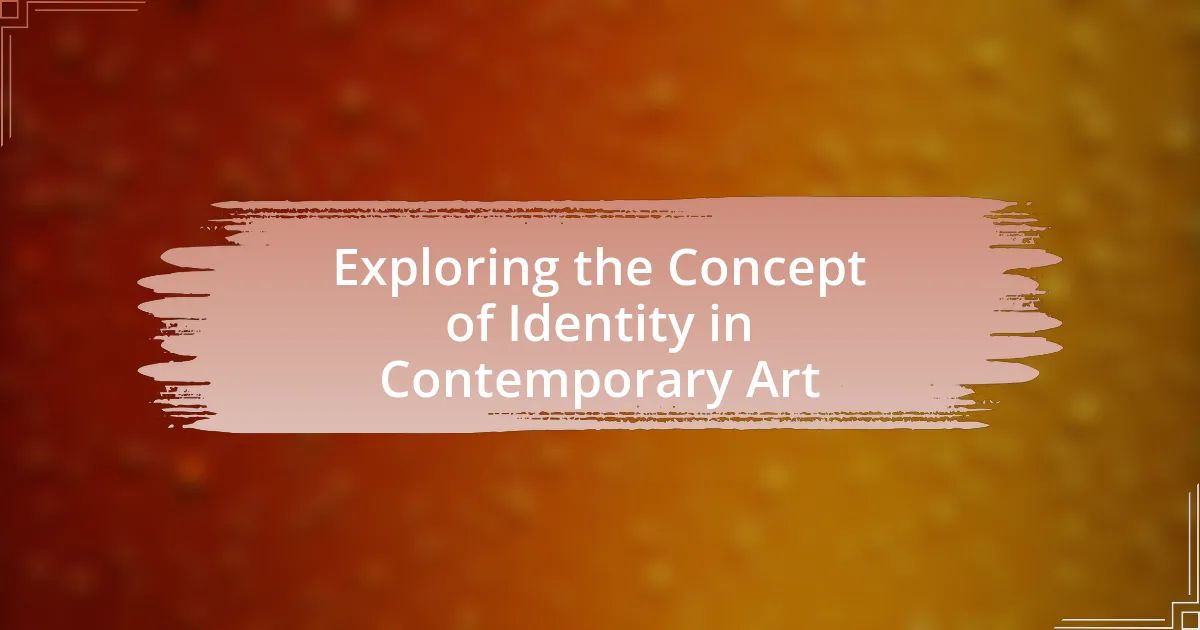The article explores the concept of identity in contemporary art, focusing on how artists represent individual and collective identities through themes such as race, gender, sexuality, and cultural heritage. It examines the evolution of identity definitions in art, influenced by historical factors like colonialism and globalization, and highlights the impact of cultural shifts on artistic representation. Key artists, movements, and mediums are discussed, illustrating how identity shapes both artistic expression and audience interpretation. The article emphasizes the significance of identity as a theme in contemporary art, fostering dialogue about personal and societal narratives.

What is the Concept of Identity in Contemporary Art?
The concept of identity in contemporary art refers to the exploration and representation of individual and collective identities through various artistic practices. Artists often engage with themes such as race, gender, sexuality, and cultural heritage, reflecting the complexities of identity in a globalized world. For instance, works by artists like Kehinde Wiley and Cindy Sherman challenge traditional notions of identity by subverting stereotypes and questioning societal norms. This engagement with identity is crucial as it allows for a deeper understanding of personal and social narratives, making art a powerful medium for dialogue and reflection on contemporary issues.
How has the definition of identity evolved in the context of contemporary art?
The definition of identity in the context of contemporary art has evolved to encompass a broader and more fluid understanding, reflecting diverse cultural, social, and personal narratives. Historically, identity was often tied to fixed categories such as race, gender, and nationality; however, contemporary artists increasingly challenge these boundaries by exploring intersectionality and the multiplicity of identities. For instance, artists like Kehinde Wiley and Yoko Ono utilize their work to address issues of representation and the complexities of identity in a globalized world. This shift is evidenced by the rise of movements such as identity politics in the 1980s and the ongoing discourse surrounding post-colonialism, which have significantly influenced how identity is perceived and expressed in art today.
What historical factors have influenced the contemporary understanding of identity?
Historical factors that have influenced the contemporary understanding of identity include colonialism, globalization, and social movements. Colonialism has shaped identities through the imposition of foreign cultures and the marginalization of indigenous identities, leading to a complex interplay of cultural influences. Globalization has facilitated the exchange of ideas and cultural practices, resulting in hybrid identities that reflect a blend of local and global influences. Social movements, particularly those advocating for civil rights, gender equality, and LGBTQ+ rights, have challenged traditional notions of identity and expanded the understanding of selfhood to include diverse experiences and perspectives. These factors collectively contribute to a more nuanced and multifaceted contemporary understanding of identity.
How do cultural shifts impact the representation of identity in art?
Cultural shifts significantly impact the representation of identity in art by altering the themes, subjects, and styles artists choose to explore. For instance, the civil rights movement in the 1960s led to a surge in artworks that addressed racial identity and social justice, as seen in the works of artists like Faith Ringgold and David Hammons. Similarly, the rise of LGBTQ+ rights has influenced contemporary art, prompting artists such as Keith Haring and Cindy Sherman to challenge traditional notions of gender and sexuality. These shifts reflect broader societal changes and encourage artists to engage with diverse identities, ultimately reshaping the narrative of identity in the art world.
Why is identity a significant theme in contemporary art?
Identity is a significant theme in contemporary art because it reflects the complexities of personal and collective experiences in a globalized society. Artists use identity to explore issues such as race, gender, sexuality, and cultural heritage, allowing for diverse perspectives and narratives to emerge. For instance, the works of artists like Kehinde Wiley and Frida Kahlo challenge traditional representations and highlight marginalized voices, demonstrating how identity shapes individual and societal understanding. This focus on identity not only fosters dialogue about social issues but also encourages viewers to engage with their own identities and the identities of others, making it a crucial element in contemporary artistic expression.
What role does identity play in the artist’s expression?
Identity plays a crucial role in an artist’s expression by shaping their perspective, themes, and techniques. Artists often draw from their personal, cultural, and social identities to convey messages that resonate with their experiences and viewpoints. For instance, artists like Frida Kahlo used their identity to explore themes of gender, race, and personal trauma, which deepened the emotional impact of their work. This connection between identity and artistic expression is supported by research indicating that an artist’s background influences their creative choices and the narratives they present, as seen in the diverse representations in contemporary art movements.
How does identity influence audience interpretation of art?
Identity significantly influences audience interpretation of art by shaping individual perspectives and emotional responses. Factors such as race, gender, culture, and personal experiences create diverse lenses through which viewers engage with artworks. For instance, a study by the National Endowment for the Arts found that individuals from different cultural backgrounds often interpret the same piece of art in varied ways, highlighting how identity informs meaning-making. This variation in interpretation underscores the importance of recognizing the role of identity in understanding artistic expression and its impact on societal narratives.

What are the Different Aspects of Identity Explored in Contemporary Art?
Contemporary art explores various aspects of identity, including race, gender, sexuality, and cultural heritage. Artists utilize their work to challenge societal norms and express personal narratives, often reflecting the complexities of identity in a globalized world. For instance, the works of artists like Kehinde Wiley address race and representation, while those of Frida Kahlo delve into gender and personal identity. These explorations are evident in exhibitions and art movements that prioritize diverse voices, highlighting the intersectionality of identity.
How do artists address personal identity in their work?
Artists address personal identity in their work by exploring themes such as culture, gender, race, and individual experiences. Through various mediums, they reflect their own backgrounds and societal influences, often using autobiographical elements to convey their unique perspectives. For instance, artists like Frida Kahlo utilized self-portraiture to express her personal struggles and cultural identity, while contemporary artists like Kehinde Wiley challenge traditional representations of race and identity in portraiture. This approach not only personalizes their art but also invites viewers to engage with broader discussions about identity in society.
What techniques do artists use to convey their personal narratives?
Artists use techniques such as symbolism, autobiographical elements, and mixed media to convey their personal narratives. Symbolism allows artists to embed deeper meanings within their work, often using objects or colors to represent personal experiences or emotions. Autobiographical elements, including self-portraits or personal stories, provide direct insight into the artist’s life and identity. Mixed media combines various materials and forms, enabling artists to express complex narratives that reflect their multifaceted identities. These techniques are evident in works by artists like Frida Kahlo, whose use of symbolism and personal imagery vividly illustrates her life experiences and struggles.
How does personal identity intersect with broader social issues in art?
Personal identity intersects with broader social issues in art by serving as a lens through which artists express and critique societal norms, inequalities, and cultural narratives. For instance, artists like Kehinde Wiley and Frida Kahlo utilize their personal backgrounds to challenge racial and gender stereotypes, thereby addressing issues such as representation and identity politics. This intersection is evident in movements like feminism and LGBTQ+ rights, where personal experiences inform artistic expression and provoke discussions about systemic oppression. The impact of personal identity in art is further supported by studies, such as the 2019 report by the National Endowment for the Arts, which highlights how diverse artistic voices contribute to social change and community engagement.
What role does cultural identity play in contemporary artistic practices?
Cultural identity plays a crucial role in contemporary artistic practices by influencing the themes, techniques, and narratives artists choose to explore. Artists often draw from their cultural backgrounds to express personal and collective experiences, thereby enriching the art with diverse perspectives. For instance, the works of artists like Ai Weiwei and Frida Kahlo reflect their cultural identities and address social issues, highlighting how cultural context shapes artistic expression. This connection between cultural identity and art fosters dialogue about identity, heritage, and societal challenges, making it a vital component of contemporary artistic discourse.
How do artists from diverse backgrounds express their cultural identities?
Artists from diverse backgrounds express their cultural identities through various mediums, including visual art, music, and performance. They often incorporate traditional symbols, narratives, and techniques that reflect their heritage, allowing them to communicate personal and collective experiences. For instance, artists like Frida Kahlo used self-portraits to explore her Mexican identity and personal struggles, while contemporary artists such as Ai Weiwei address cultural and political issues relevant to their backgrounds. This expression not only fosters a deeper understanding of their cultures but also challenges dominant narratives in the art world, as evidenced by the increasing recognition of multicultural perspectives in exhibitions and art markets globally.
What impact does globalization have on cultural identity in art?
Globalization significantly influences cultural identity in art by facilitating the exchange of ideas, styles, and practices across diverse cultures. This interconnectedness allows artists to blend traditional elements with contemporary influences, resulting in hybrid forms of expression that reflect a globalized society. For instance, the rise of multicultural art movements, such as Afro-futurism, showcases how artists incorporate their cultural heritage while engaging with global themes, thus redefining their identities. Additionally, the accessibility of digital platforms enables artists from various backgrounds to share their work internationally, further enriching the dialogue around cultural identity in art.

How is Identity Represented in Various Mediums of Contemporary Art?
Identity is represented in various mediums of contemporary art through diverse approaches that reflect personal, cultural, and social narratives. Artists utilize mediums such as painting, sculpture, photography, and digital art to explore themes of race, gender, sexuality, and nationality, often challenging traditional notions of identity. For instance, Kehinde Wiley’s portraiture recontextualizes historical representations of Black identity, while Cindy Sherman’s photography examines the construction of female identity through performance and persona. These works demonstrate how contemporary art serves as a platform for dialogue about identity, allowing for multifaceted interpretations and reflections on the self in relation to society.
What mediums are most commonly used to explore identity in contemporary art?
The most commonly used mediums to explore identity in contemporary art include photography, video, installation, and performance art. Photography allows artists to capture and manipulate images that reflect personal and cultural narratives, while video art provides a dynamic platform for storytelling and self-representation. Installation art creates immersive environments that engage viewers in the exploration of identity through spatial relationships and material choices. Performance art emphasizes the body as a medium, allowing artists to express identity through live actions and interactions. These mediums are frequently employed by artists to challenge societal norms and provoke discussions about race, gender, sexuality, and cultural heritage, thereby reinforcing their relevance in contemporary discourse on identity.
How does the choice of medium affect the representation of identity?
The choice of medium significantly affects the representation of identity by influencing how individuals express and perceive their personal and cultural narratives. Different mediums, such as painting, sculpture, photography, or digital art, offer unique capabilities and limitations that shape the way identity is conveyed. For instance, photography can capture real-life moments and evoke authenticity, while abstract painting may allow for more subjective interpretations of identity. Research by art theorist Amelia Jones highlights that the medium can alter the viewer’s engagement and emotional response, thus impacting the overall understanding of the identity being represented. This demonstrates that the selection of a specific medium is not merely a technical choice but a crucial factor in the articulation and reception of identity in contemporary art.
What are some notable examples of identity exploration in different mediums?
Notable examples of identity exploration in different mediums include the film “Moonlight,” which examines the complexities of race, sexuality, and identity through the life of a young Black man. In literature, “The Brief Wondrous Life of Oscar Wao” by Junot Díaz explores Dominican-American identity and the immigrant experience. In visual art, Kehinde Wiley’s portraits challenge traditional representations of Black identity by placing subjects in classical poses. Additionally, the video game “Life is Strange” allows players to navigate themes of identity, choice, and consequence through the character of Max Caulfield, who grapples with her own identity and relationships. These examples illustrate how various mediums can effectively convey the multifaceted nature of identity.
How do contemporary art movements reflect changing notions of identity?
Contemporary art movements reflect changing notions of identity by challenging traditional representations and embracing diverse perspectives. For instance, movements such as Feminism, LGBTQ+ Art, and Postcolonial Art have emerged to address issues of gender, sexuality, and cultural identity, respectively. These movements utilize various mediums and techniques to express the complexities of identity in a globalized world. The rise of artists like Kehinde Wiley and Cindy Sherman illustrates how contemporary art critiques societal norms and highlights marginalized voices, thereby reshaping the understanding of identity. Furthermore, exhibitions like “The Body” at the Museum of Contemporary Art in Chicago demonstrate how contemporary art engages with identity politics, showcasing works that explore race, gender, and personal narratives. This evolution in art reflects broader societal shifts towards inclusivity and recognition of multifaceted identities.
What movements have significantly contributed to the discourse on identity?
The movements that have significantly contributed to the discourse on identity include feminism, LGBTQ+ rights, postcolonialism, and critical race theory. Feminism has challenged traditional gender roles and highlighted the intersectionality of identity, as seen in the works of artists like Judy Chicago and Cindy Sherman. LGBTQ+ rights movements have emphasized the fluidity of gender and sexual identity, influencing artists such as David Hockney and Keith Haring. Postcolonialism has critiqued colonial narratives and explored cultural identity, with artists like Yinka Shonibare addressing issues of race and heritage. Critical race theory has examined the social constructs of race and identity, impacting artists like Kara Walker and Theaster Gates. These movements have collectively reshaped the understanding of identity in contemporary art, reflecting diverse experiences and perspectives.
How do these movements challenge traditional views of identity?
These movements challenge traditional views of identity by promoting fluidity and multiplicity over fixed categories. Contemporary art movements, such as queer art and postcolonial art, emphasize that identity is not a singular or static construct but rather a dynamic interplay of various social, cultural, and personal factors. For instance, queer artists often deconstruct binary notions of gender and sexuality, illustrating that identity can encompass a spectrum of experiences rather than conforming to traditional labels. Similarly, postcolonial artists critique colonial narratives, revealing how identity is shaped by historical context and power dynamics. This shift towards recognizing diverse identities disrupts conventional frameworks, encouraging a more inclusive understanding of self that reflects the complexities of modern society.
What are some practical approaches to engaging with identity in contemporary art?
Practical approaches to engaging with identity in contemporary art include utilizing multimedia installations, participatory art practices, and community-based projects. Multimedia installations allow artists to explore identity through various formats, such as video, sound, and interactive elements, creating immersive experiences that reflect diverse perspectives. Participatory art practices invite audience involvement, fostering dialogue and collaboration that can reveal personal and collective identities. Community-based projects often focus on local narratives, encouraging artists to work with specific groups to highlight their unique experiences and histories. These methods have been employed by artists like Ai Weiwei and Theaster Gates, who emphasize the importance of context and collaboration in their work, demonstrating the effectiveness of these approaches in addressing complex identity issues.
How can artists effectively communicate their identity through their work?
Artists can effectively communicate their identity through their work by incorporating personal narratives, cultural symbols, and unique stylistic choices that reflect their experiences and backgrounds. For instance, artists like Frida Kahlo used self-portraits to explore her identity, drawing on her Mexican heritage and personal struggles, which resonated with audiences and conveyed deep emotional truths. Additionally, contemporary artists often utilize mixed media and interactive installations to engage viewers, allowing them to experience the artist’s identity in a multifaceted way. This approach not only showcases the artist’s individuality but also invites dialogue about broader social and cultural issues, reinforcing the connection between personal identity and collective experience.
What strategies can audiences use to deepen their understanding of identity in art?
Audiences can deepen their understanding of identity in art by engaging in critical analysis, contextual research, and participatory experiences. Critical analysis involves examining the themes, symbols, and techniques used by artists to express identity, which can reveal underlying messages and cultural narratives. Contextual research allows audiences to explore the historical, social, and political backgrounds of the artworks, enhancing their comprehension of how identity is shaped and represented. Participatory experiences, such as workshops or discussions with artists, foster direct engagement and personal reflection, enabling audiences to connect their own identities with the art. These strategies collectively enhance the appreciation and interpretation of identity in contemporary art.


